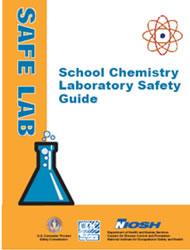
 |
|||
|
NIOSH Publication No. 2007-107:School Chemistry Laboratory Safety Guide
|
October 2006
|
|
What are Some Strategies to Reduce the Amount and/or Toxicity of Chemical Waste Generated in the Laboratory?All laboratories that use chemicals inevitably produce chemical waste that must be properly disposed of. It is crucial to minimize both the toxicity and the amount of chemical waste that is generated. A waste management and reduction policy that conforms to State and local regulations should be established by the school or school district. Several things that can be done to minimize hazards, waste generation, and control costs:
For information about the EPA’s Green Chemistry Program, which promotes the use of innovative technologies to reduce or eliminate the use or generation of hazardous substances, visit:
What is the Recommended Procedure for Chemical Disposal?Any chemical discarded or intended to be discarded is chemical waste. HAZARDOUS chemical waste as designated by the Environmental Protection Agency (EPA) or State authority is waste that presents a danger to human health and/or the environment. According to EPA regulations, there are four characteristics that define a waste as hazardous:
In addition, there are lists of hundreds of other chemicals that EPA has determined to be hazardous waste. Because of particular differences within some States, consult your State or regional EPA office to determine whether waste is considered hazardous and the requirements for storage and disposal. For chemical waste, it may be best to use a log book to contain detailed lists of materials in a container labeled "organic waste", for example. Storing Chemical Waste
Proper Disposal of Chemical WasteThe EPA has written a comprehensive set of regulations that govern the management of hazardous waste from the point of generation to ultimate disposal (www.epa.gov/epaoswer/osw/conserve/clusters/schools/index.htm) Generators of hazardous waste are responsible for ensuring proper disposal of their hazardous waste and can incur liability for improper disposal of their hazardous waste. Disposal Procedure
|

|
||||||||||||||||||||||